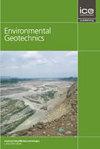计算流体力学与离散元法耦合求解岩土工程问题的研究进展
IF 2.2
4区 工程技术
Q3 ENGINEERING, GEOLOGICAL
引用次数: 0
摘要
在某些情况下,颗粒土中的含水量增加到饱和的程度,这明显改变了其响应。例如,饱和颗粒土的孔隙水压力在突发性外荷载作用下会迅速增大,相当于不排水或等体积条件。这大大降低了土壤中的有效应力,并可能导致灾难性破坏。已有不同的数值方法来分析土壤的这种破坏机制,以便在微观层面上对土壤行为有更深入的了解。这种分析最常用的数值工具之一是离散元法(DEM),因为它在获得微观特性(例如,粒子接触和织物的统计数据)、可重复性和简单的反馈控制方面具有优势。然而,大多数DEM研究忽略了流体相,只考虑固体颗粒,而流体压力是通过模拟不排水条件到定容条件来间接计算的。注意,流体的影响并不局限于孔隙水压力的变化。例如,外部载荷会引起流体的运动,流固相互作用随后会拖动固体颗粒在系统内移动。此外,在过大的水力梯度作用下,土壤的状态可能由固体变为悬浮。因此,研究流固混合体是岩土工程实践中的一种典型情况,饱和砂土的模拟应以可模拟固相和流体相的数值形式进行。本文章由计算机程序翻译,如有差异,请以英文原文为准。
Advances in Coupling Computational Fluid Dynamics and Discrete Element Method in Geotechnical Problems
In some cases, the water content in granular soil increases to the extent that it becomes saturated, which noticeably alters its responses. For example, the pore water pressure within saturated granular soil would increase rapidly under sudden external loading, which is equivalent to undrained or constant volume conditions. This reduces the effective stress in soil dramatically and may result in catastrophic failure. There have been different numerical approaches to analyse such a failure mechanism of soil to provide a deeper understanding of soil behaviour at the microscopic level. One of the most common numerical tools for such analysis is the discrete element method (DEM) due to its advantage in obtaining microscopic properties (e.g., statistics on particle contacts and fabric), reproducibility and simple feedback control. However, most DEM studies ignore the fluid phase and merely consider the solid particles while the fluid pressure is indirectly calculated by mimicking undrained condition to a constant volume condition. Note that fluid’s influence does not limit to the change of pore water pressure. For example, the external loading would induce the movement of fluid, and the fluid-solid interaction could subsequently drag the solid particles to shift within the system. In addition, the state of soil could change from solid to suspension under an excess hydraulic gradient. Therefore, the study of the fluid-solid mixture is essential as it is a typical scenario in geotechnical practice, and the simulations of saturated sand should be conducted in numerical forms in which both the solid and fluid phases can be modelled.
求助全文
通过发布文献求助,成功后即可免费获取论文全文。
去求助
来源期刊

Environmental geotechnics
Environmental Science-Water Science and Technology
CiteScore
6.20
自引率
18.20%
发文量
53
期刊介绍:
In 21st century living, engineers and researchers need to deal with growing problems related to climate change, oil and water storage, handling, storage and disposal of toxic and hazardous wastes, remediation of contaminated sites, sustainable development and energy derived from the ground.
Environmental Geotechnics aims to disseminate knowledge and provides a fresh perspective regarding the basic concepts, theory, techniques and field applicability of innovative testing and analysis methodologies and engineering practices in geoenvironmental engineering.
The journal''s Editor in Chief is a Member of the Committee on Publication Ethics.
All relevant papers are carefully considered, vetted by a distinguished team of international experts and rapidly published. Full research papers, short communications and comprehensive review articles are published under the following broad subject categories:
geochemistry and geohydrology,
soil and rock physics, biological processes in soil, soil-atmosphere interaction,
electrical, electromagnetic and thermal characteristics of porous media,
waste management, utilization of wastes, multiphase science, landslide wasting,
soil and water conservation,
sensor development and applications,
the impact of climatic changes on geoenvironmental, geothermal/ground-source energy, carbon sequestration, oil and gas extraction techniques,
uncertainty, reliability and risk, monitoring and forensic geotechnics.
 求助内容:
求助内容: 应助结果提醒方式:
应助结果提醒方式:


